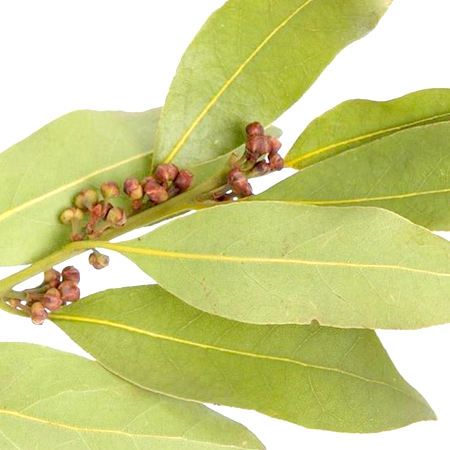




Botanical name Pimenta Racemosa
Botanical synonym Pimenta acris Wight
Family Myrtaceae
Source Leaves
Origin West India
Processing Method Steam Distillation
Color/Consistency This can be from a pale yellow green to orange brown liquid with a thin consistency.
Aromatic Summary / Note / Strength of Aroma Bay has a spicy bay leaf scent with a strong top note.
Blend with Bergamot, Virginian, Cedarwood, Eucalyptus,Fenenl, Ginger, Orange, Patchouli, Rosemary, Ylang-Ylang
Product Abstract
The West Indian Bay leaf — pimenta racemosa — is much more fragrant and aromatic than its Turkish, Indonesian, Californian or Indian cousins. Its flavor is intense and highly spiced, with complex notes of cinnamon, clove and nutmeg along with hints of vanilla and cardamom. If you rub the leaves, the distinctive scent will remain on your fingers for hours.
A member of the myrtle family, Pimenta racemosa -- commonly called the bay rum tree -- provides ornamental value to landscapes with its peeling gray bark and dark green oval leaves. The leaves emit a woody, spicy fragrance that becomes stronger when crushed.
Harvesting/Extraction Information
The bay rum tree has a tolerance for salty soils and wind, making it a fitting choice for coastal landscapes. Hardy in U.S. Department of Agriculture plant hardiness zones 10 through 11, this tropical evergreen grows in full to partial sunlight and fast-draining, nutrient-rich soils.
Common Usage
Caution
Only the leaves of pimenta racemosa can be used in cookin , teas and essential oil. All other parts of the plant, including the small black berries surrounded by a lacy network of white flowers, are not edible and should not be ingested. Despite the name, the "rum" isn't drinkable — it's toxic.
Key constituents
Eugenol 44.4–56.2%
b-Myrcene 6.4–25.0%
Chavicol 9.3–21.6%
Chavicol 9.3–21.6%
Linalool 1.7–6.0%
(þ)-Limonene 0.8–3.9%
1-Octen -3-ol 0.9–2.0%
1,8-cineole 0.2–1.4%
Methyleugenol 0–1.4%
(E)-b-Ocimene 0–1.4%
Terpinen-4-ol 0.3–1.2%
3-Octanone 0.8–1.1%
d-Cadinene 0.6–1.0%
3-Octanol 0.6–1.0%
p-Cymene 0.1–1.0%
Estragole tr–0.1%
Safety summary
Hazards Drug interaction; may contain estragole and methyleugenol; may inhibit blood clotting; skin sensitization (low risk);
mucous membrane irritation (low risk).
Cautions (oral) May interact with pethidine, MAOIs or SSRIs. Anticoagulant medication, major surgery, peptic ulcer, hemophilia, other bleeding disorders.
Maximum adult daily oral dose 50 mg Maximum dermal use level
EU 0.01%
IFRA 0.02%
Tisserand & Young 1.4%
Maximum dermal use level (based on eugenol content)
EU No legal limit
IFRA 0.9%
Tisserand & Young 0.9%
Our safety advice
We recommend a dermal maximum of 0.9%, based on 56.2% eugenol content and a limit of 0.5%. Our oral maximum is based on 1.4% methyleugenol, and a limit of 0.01 mg/kg/day.
Regulatory guidelines IFRA recommends that the maximum concentration of methyleugenol for leave-on products such as body lotion should be 0004%. The equivalent SCCNFP maximum is 0.0002%.
Organ-specific effects Adverse skin reactions Tested at 10% on 25 volunteers West Indian bay oil was neither irritating nor sensitizing. Eugenol is a potential cause of skin sensitization in dermatitis patients.
Cardiovascular effects Eugenol inhibits platelet aggregation, an essential step in the blood clotting cascade.
Systemic effects
Acute toxicity West Indian bay oil acute oral LD50 in rats 1.8 g/kg; acute dermal LD50 in rabbits >5 mL/kg.
Antioxidant/pro-oxidant activity West Indian bay oil inhibited lipid peroxidation, and scavenged both DPPH radicals and OH radicals (0.6 mg/mL), almost as efficiently as eugenol. Eugenol and chavicol are potent antioxidants in lipid systems.
Carcinogenic/anticarcinogenic potential No information! found. Methyleugenol is a rodent hepatocarcinogen when exposure is sufficiently high; eugenol, (þ)-limonene and linalool display anti-liver cancer activity in vitro, and in vivo for(þ)- limonene in rats.
Drug interactions Anticoagulant medication, because of cardiovascular effects, above. Since eugenol significantly inhibits human MAO-A, oral doses of eugenol-rich essential oils may interact with pethidine, indirect sympathomimetics, MAOIs or SSRIs.
Comments There are few published analyses ofWest Indian bay oil, and since the methyleugenol content is a critical safety issue, it is worthy of some detailed remarks. There are five varieties of Pimenta racemosa, and there are three chemotypes of the racemosa variety: the commercial ‘clove’ type, rich in eugenol, a ‘lemon’ (citral) type, and an ‘anise’ type with, in one analysis, 32.8% estragole, and 48.1% methyleugenol. Only the eugenol type is produced commercially. The oil is distilled in the West Indies, primarily Dominica. In 1933, a commercial oil from the Virgin Islands was said to contain little, if any, methyleugenol, and in 1977 a Dominican oil was reported to contain only traces. In 1991, no methyleugenol was detectedin a commercial oil; in 1995 an oil from Guadaloupe had 1.4%; in 2007 a Jamaican oil contained 1.02%, and in 2008, a commercial oil had 0.45%. The estragole content of West Indian bay oil is not sufficiently high to be of concern. West Indian bay oil is hydrodistilled, and separates into two fractions, one lighter and one heavier than water. These are re-combined to form the normal oil of commerce. This oil should not be confused with laurel leaf oil, which is also known as bay leaf.